Taxation Law Questions and Answers - HI6028, T1 2019, Holmes Institute
VerifiedAdded on 2023/01/10
|7
|2368
|28
Homework Assignment
AI Summary
This document presents a comprehensive solution to a Taxation Law assignment, focusing on various aspects of Australian taxation. The assignment addresses three key questions, each exploring different facets of tax law. The first question delves into Capital Gains Tax (CGT), analyzing the tax implications of selling different assets, including pre-CGT assets like paintings and collectables such as historical sculptures and antique jewelry, and applying relevant legislation and case law. The second question focuses on income tax, examining the tax consequences of income derived from personal exertion, particularly in scenarios involving economists, writing books, and assigning copyrights. The analysis considers the nexus between service provision and income generation. The third question addresses the tax liability of interest received from a loan agreement, differentiating between ordinary and statutory income, and applying relevant legal principles. Each question incorporates relevant case law and legislation to support the analysis and provide a clear understanding of the tax implications. The assignment adheres to the HI6028 Taxation Theory, Practice & Law assessment guidelines for T1 2019 at Holmes Institute.
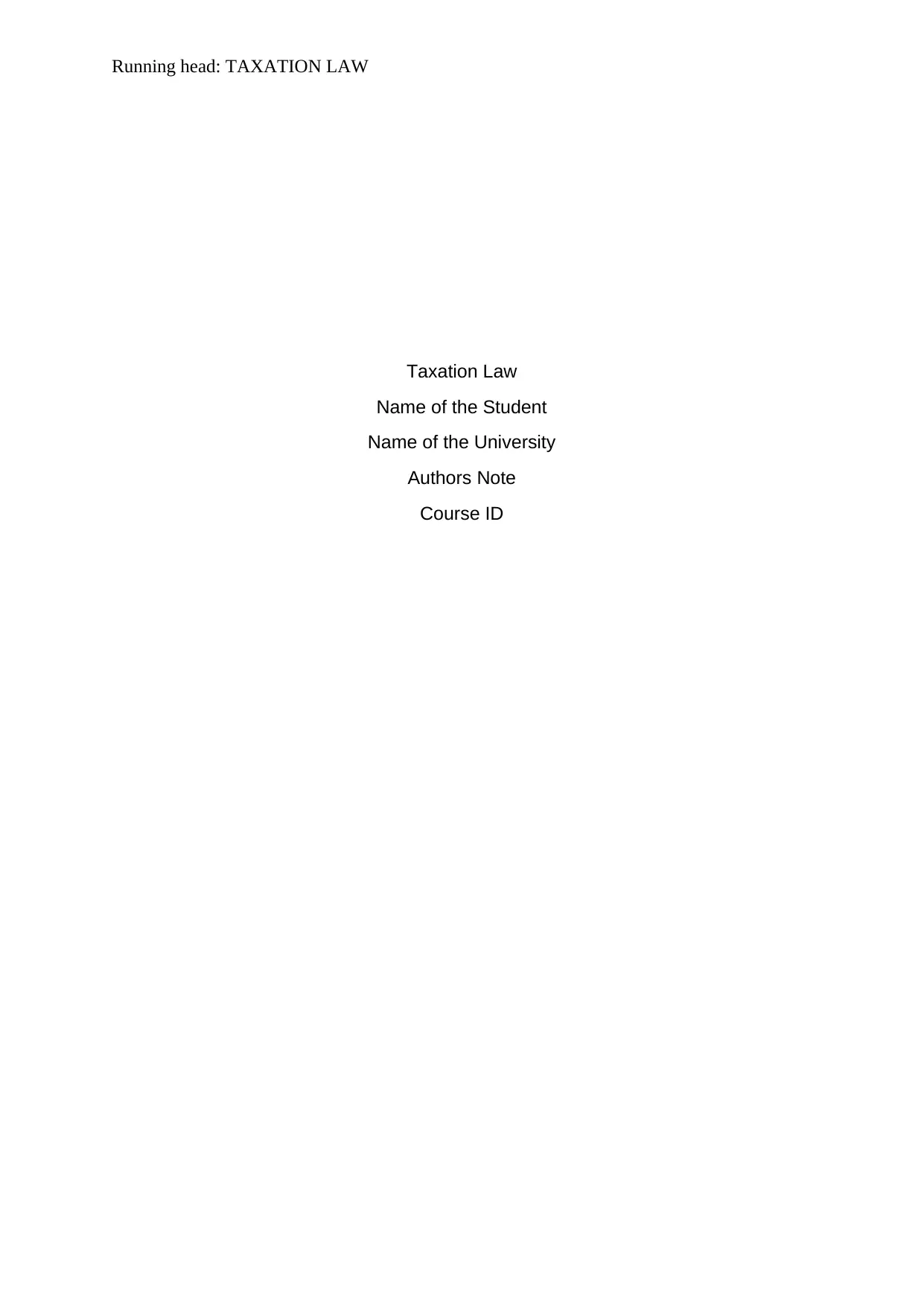
Running head: TAXATION LAW
Taxation Law
Name of the Student
Name of the University
Authors Note
Course ID
Taxation Law
Name of the Student
Name of the University
Authors Note
Course ID
Paraphrase This Document
Need a fresh take? Get an instant paraphrase of this document with our AI Paraphraser
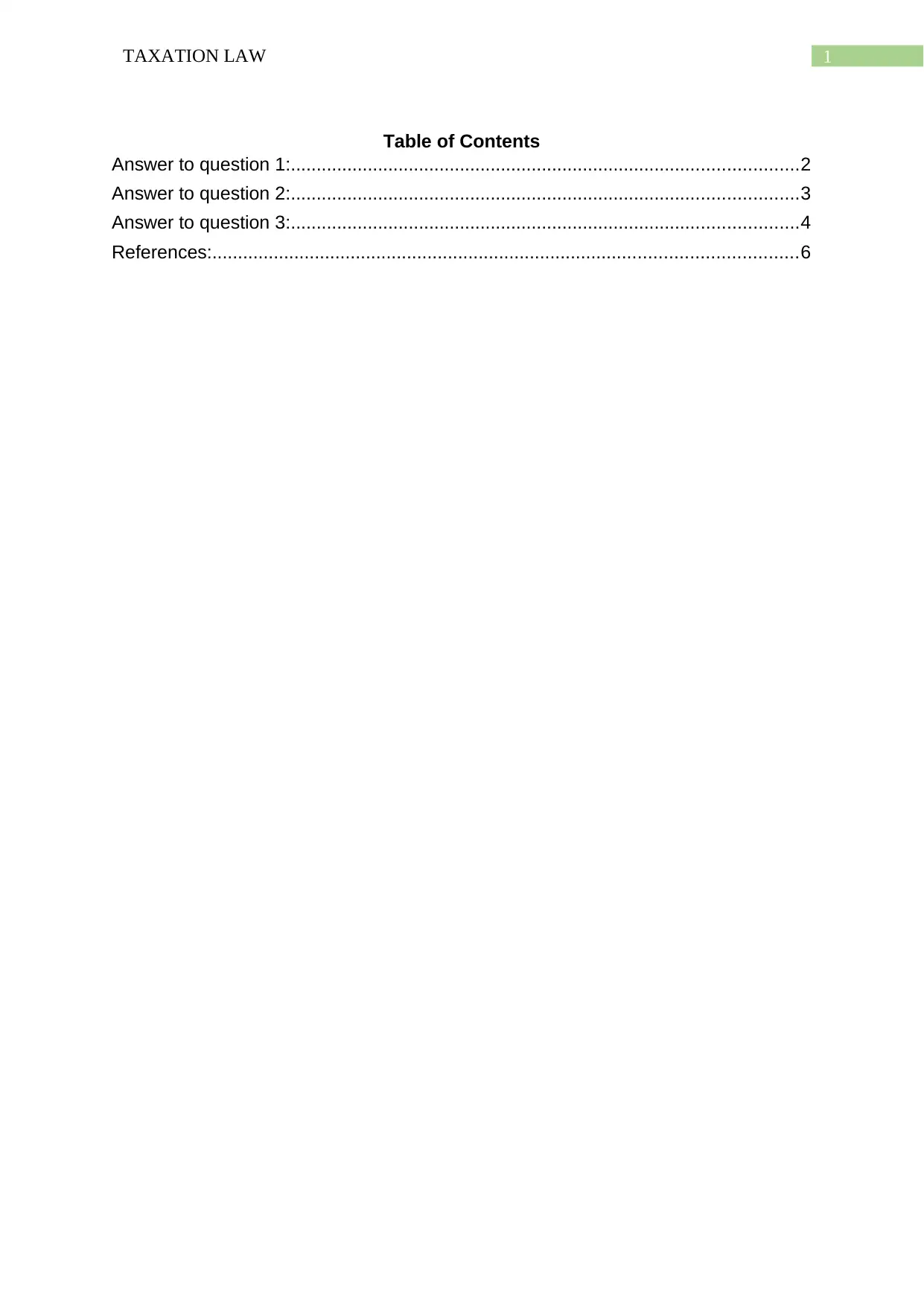
1TAXATION LAW
Table of Contents
Answer to question 1:...................................................................................................2
Answer to question 2:...................................................................................................3
Answer to question 3:...................................................................................................4
References:..................................................................................................................6
Table of Contents
Answer to question 1:...................................................................................................2
Answer to question 2:...................................................................................................3
Answer to question 3:...................................................................................................4
References:..................................................................................................................6
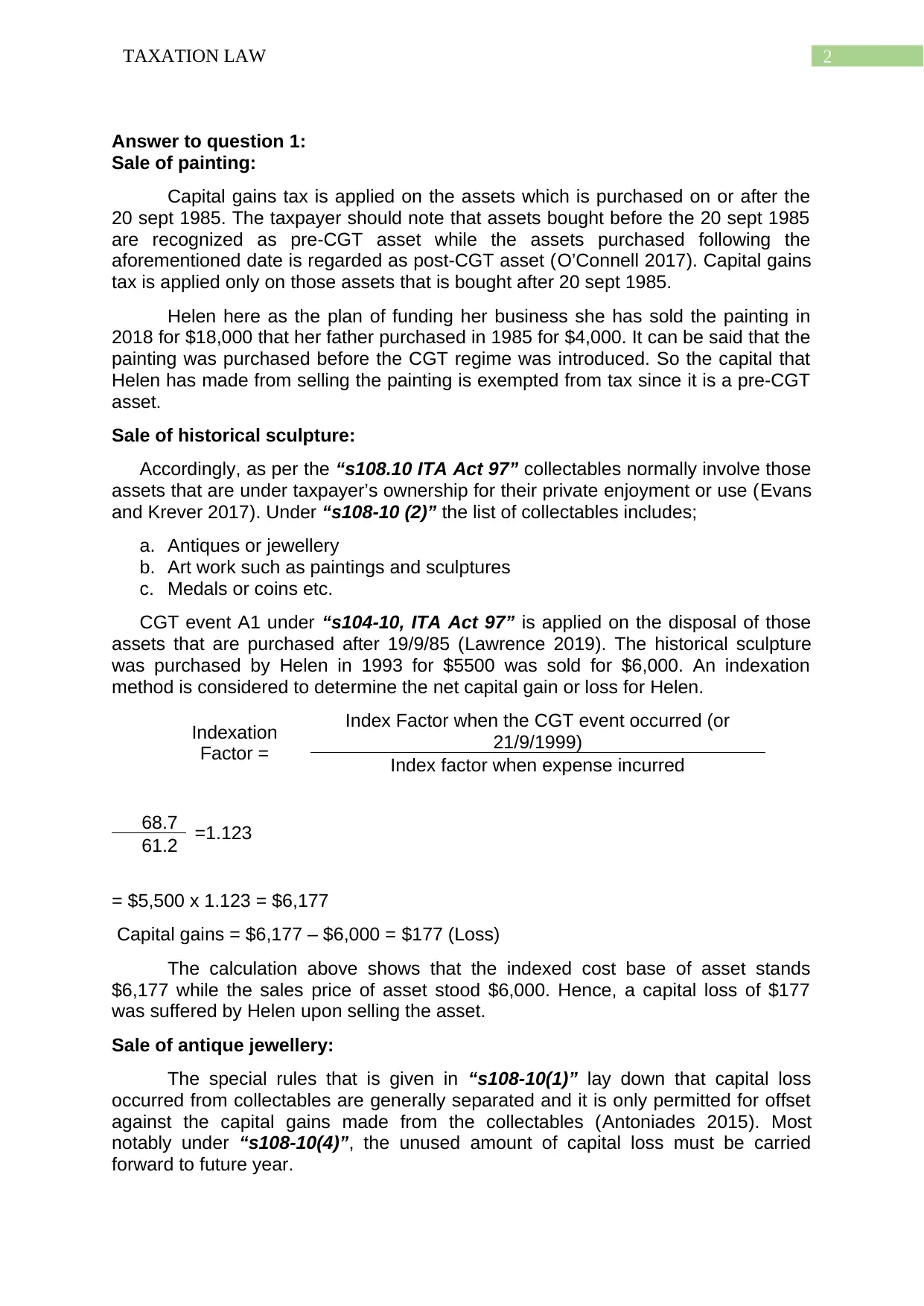
2TAXATION LAW
Answer to question 1:
Sale of painting:
Capital gains tax is applied on the assets which is purchased on or after the
20 sept 1985. The taxpayer should note that assets bought before the 20 sept 1985
are recognized as pre-CGT asset while the assets purchased following the
aforementioned date is regarded as post-CGT asset (O’Connell 2017). Capital gains
tax is applied only on those assets that is bought after 20 sept 1985.
Helen here as the plan of funding her business she has sold the painting in
2018 for $18,000 that her father purchased in 1985 for $4,000. It can be said that the
painting was purchased before the CGT regime was introduced. So the capital that
Helen has made from selling the painting is exempted from tax since it is a pre-CGT
asset.
Sale of historical sculpture:
Accordingly, as per the “s108.10 ITA Act 97” collectables normally involve those
assets that are under taxpayer’s ownership for their private enjoyment or use (Evans
and Krever 2017). Under “s108-10 (2)” the list of collectables includes;
a. Antiques or jewellery
b. Art work such as paintings and sculptures
c. Medals or coins etc.
CGT event A1 under “s104-10, ITA Act 97” is applied on the disposal of those
assets that are purchased after 19/9/85 (Lawrence 2019). The historical sculpture
was purchased by Helen in 1993 for $5500 was sold for $6,000. An indexation
method is considered to determine the net capital gain or loss for Helen.
Indexation
Factor =
Index Factor when the CGT event occurred (or
21/9/1999)
Index factor when expense incurred
68.7 =1.123
61.2
= $5,500 x 1.123 = $6,177
Capital gains = $6,177 – $6,000 = $177 (Loss)
The calculation above shows that the indexed cost base of asset stands
$6,177 while the sales price of asset stood $6,000. Hence, a capital loss of $177
was suffered by Helen upon selling the asset.
Sale of antique jewellery:
The special rules that is given in “s108-10(1)” lay down that capital loss
occurred from collectables are generally separated and it is only permitted for offset
against the capital gains made from the collectables (Antoniades 2015). Most
notably under “s108-10(4)”, the unused amount of capital loss must be carried
forward to future year.
Answer to question 1:
Sale of painting:
Capital gains tax is applied on the assets which is purchased on or after the
20 sept 1985. The taxpayer should note that assets bought before the 20 sept 1985
are recognized as pre-CGT asset while the assets purchased following the
aforementioned date is regarded as post-CGT asset (O’Connell 2017). Capital gains
tax is applied only on those assets that is bought after 20 sept 1985.
Helen here as the plan of funding her business she has sold the painting in
2018 for $18,000 that her father purchased in 1985 for $4,000. It can be said that the
painting was purchased before the CGT regime was introduced. So the capital that
Helen has made from selling the painting is exempted from tax since it is a pre-CGT
asset.
Sale of historical sculpture:
Accordingly, as per the “s108.10 ITA Act 97” collectables normally involve those
assets that are under taxpayer’s ownership for their private enjoyment or use (Evans
and Krever 2017). Under “s108-10 (2)” the list of collectables includes;
a. Antiques or jewellery
b. Art work such as paintings and sculptures
c. Medals or coins etc.
CGT event A1 under “s104-10, ITA Act 97” is applied on the disposal of those
assets that are purchased after 19/9/85 (Lawrence 2019). The historical sculpture
was purchased by Helen in 1993 for $5500 was sold for $6,000. An indexation
method is considered to determine the net capital gain or loss for Helen.
Indexation
Factor =
Index Factor when the CGT event occurred (or
21/9/1999)
Index factor when expense incurred
68.7 =1.123
61.2
= $5,500 x 1.123 = $6,177
Capital gains = $6,177 – $6,000 = $177 (Loss)
The calculation above shows that the indexed cost base of asset stands
$6,177 while the sales price of asset stood $6,000. Hence, a capital loss of $177
was suffered by Helen upon selling the asset.
Sale of antique jewellery:
The special rules that is given in “s108-10(1)” lay down that capital loss
occurred from collectables are generally separated and it is only permitted for offset
against the capital gains made from the collectables (Antoniades 2015). Most
notably under “s108-10(4)”, the unused amount of capital loss must be carried
forward to future year.
⊘ This is a preview!⊘
Do you want full access?
Subscribe today to unlock all pages.

Trusted by 1+ million students worldwide

3TAXATION LAW
The case facts that is obtained of Helen suggest that an antique jewellery that
she has purchased in 1987 for $14,000 was sold for $13,000 on March 2018. The
disposal of jewellery led to capital loss for Helen. Most notably under “s108-10(4)”,
the unused amount of capital loss must be carried forward to future year by Helen.
Sale of picture:
An important rule related to collectables is mentioned under s118-10 (1) that
capital gains from collectables should be ignored when the asset is bought for less
than $500. Denoting the situation of Helen, it must be said that her mother has
bought a picture for $470 in 1987. The picture was sold for $5,000. The picture is
classified as collectible under “sec 108-10 (2)” (Ioannou 2017). As the cost of
picture is less than $500 so under “s118-10 (1)” the capital gains from picture must
be ignored by Helen.
Answer to question 2:
Issues:
The central issue that will be discussed in this problem is the tax concerns
arising from the earnings that is made from the personal exertion within the
legislation of “s-6(1), ITA Act 1936”.
Laws:
As defined in the “s 6.5, ITA Act 97” that taxable earnings that is made by
the taxpayer is treated as income based on the ordinary meaning. This kind of
income takes into the account the salaries that is earned from the employment and
the rewards that a taxpayer earns from giving personal services. As per “s6(1), ITA
Act 36” the character of payment which is received in the hands of taxpayer is
considered important (Boccabella 2015). Receipts which is associated to the
execution of services or the provision of service generally needs the nexus among
the amount and the income producing activity.
The law court in “Eisner v Macomber (1920)” observed that income might
be considered as gain that is derived from capital or from the labour and it may also
have the combination of both (Jones 2017). With respect to this, just as the income
is generally characterised as the flow from the capital asset, it can be the product of
taxpayer’s individual exertion or efforts.
Payments which a taxpayer receives from providing personal service might or
might not be treated taxable on the basis of the facts of a case. Similarly, in “Brent v
FCT 71” rewards that is received for rendering services is generally characterised as
having the nature of income (Woellner et al. 2016). The judgement in the concerned
case held that the payment which was received by robber’s wife when she granted
the media company with the right of publishing her life story was considered as
income from personal exertion and was taxable accordingly under “s6.5 ITA Act
97”.
To support the above stated payment as the product of personal services
reference to illustration of “Housden (Inspector of Taxes) v Marshall (1958)” the
taxpayer in the concerned case decided to make his experience available as the
jockey together with the photographs and the cuttings of newspaper as well.
Application:
The case facts that is obtained of Helen suggest that an antique jewellery that
she has purchased in 1987 for $14,000 was sold for $13,000 on March 2018. The
disposal of jewellery led to capital loss for Helen. Most notably under “s108-10(4)”,
the unused amount of capital loss must be carried forward to future year by Helen.
Sale of picture:
An important rule related to collectables is mentioned under s118-10 (1) that
capital gains from collectables should be ignored when the asset is bought for less
than $500. Denoting the situation of Helen, it must be said that her mother has
bought a picture for $470 in 1987. The picture was sold for $5,000. The picture is
classified as collectible under “sec 108-10 (2)” (Ioannou 2017). As the cost of
picture is less than $500 so under “s118-10 (1)” the capital gains from picture must
be ignored by Helen.
Answer to question 2:
Issues:
The central issue that will be discussed in this problem is the tax concerns
arising from the earnings that is made from the personal exertion within the
legislation of “s-6(1), ITA Act 1936”.
Laws:
As defined in the “s 6.5, ITA Act 97” that taxable earnings that is made by
the taxpayer is treated as income based on the ordinary meaning. This kind of
income takes into the account the salaries that is earned from the employment and
the rewards that a taxpayer earns from giving personal services. As per “s6(1), ITA
Act 36” the character of payment which is received in the hands of taxpayer is
considered important (Boccabella 2015). Receipts which is associated to the
execution of services or the provision of service generally needs the nexus among
the amount and the income producing activity.
The law court in “Eisner v Macomber (1920)” observed that income might
be considered as gain that is derived from capital or from the labour and it may also
have the combination of both (Jones 2017). With respect to this, just as the income
is generally characterised as the flow from the capital asset, it can be the product of
taxpayer’s individual exertion or efforts.
Payments which a taxpayer receives from providing personal service might or
might not be treated taxable on the basis of the facts of a case. Similarly, in “Brent v
FCT 71” rewards that is received for rendering services is generally characterised as
having the nature of income (Woellner et al. 2016). The judgement in the concerned
case held that the payment which was received by robber’s wife when she granted
the media company with the right of publishing her life story was considered as
income from personal exertion and was taxable accordingly under “s6.5 ITA Act
97”.
To support the above stated payment as the product of personal services
reference to illustration of “Housden (Inspector of Taxes) v Marshall (1958)” the
taxpayer in the concerned case decided to make his experience available as the
jockey together with the photographs and the cuttings of newspaper as well.
Application:
Paraphrase This Document
Need a fresh take? Get an instant paraphrase of this document with our AI Paraphraser
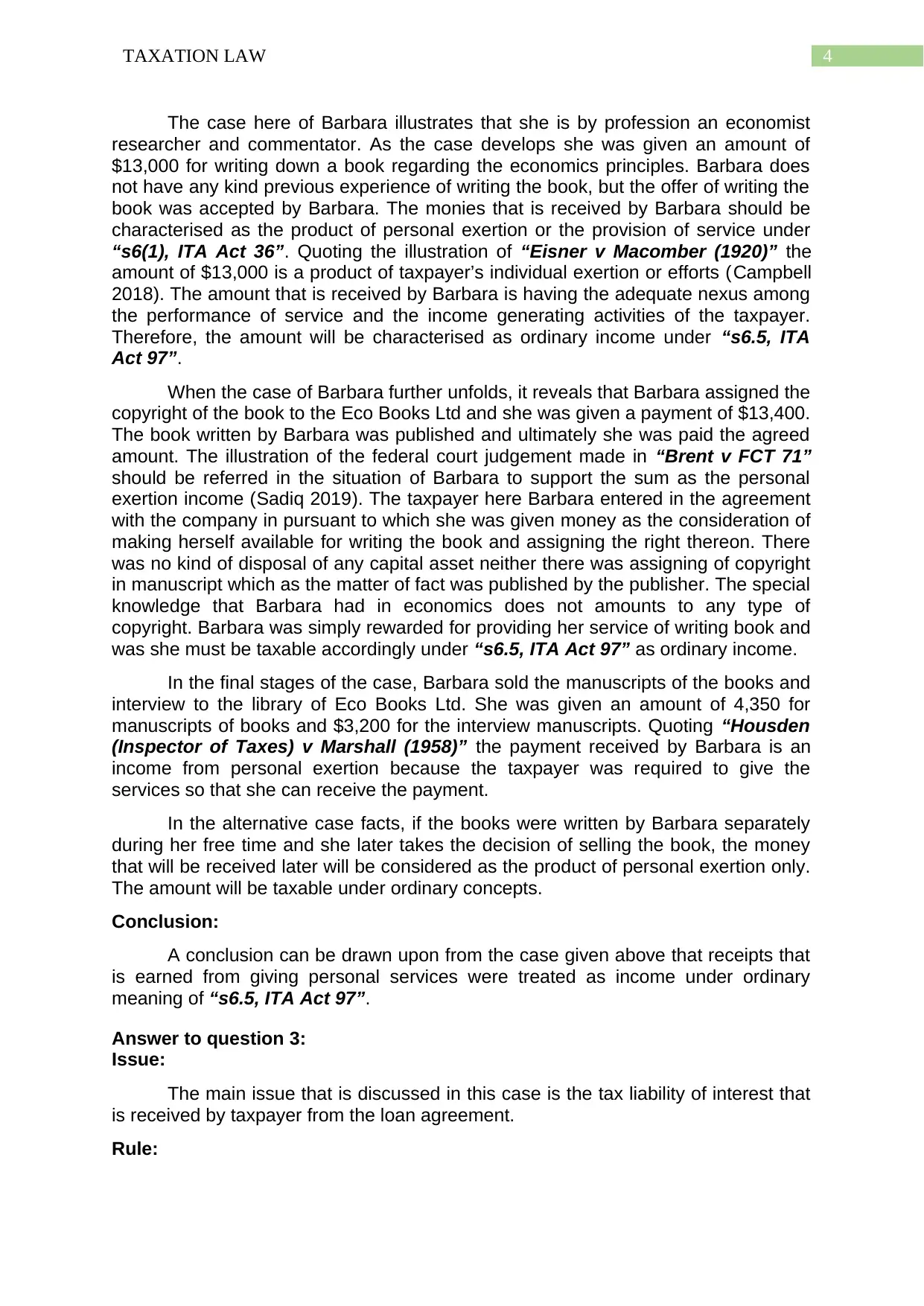
4TAXATION LAW
The case here of Barbara illustrates that she is by profession an economist
researcher and commentator. As the case develops she was given an amount of
$13,000 for writing down a book regarding the economics principles. Barbara does
not have any kind previous experience of writing the book, but the offer of writing the
book was accepted by Barbara. The monies that is received by Barbara should be
characterised as the product of personal exertion or the provision of service under
“s6(1), ITA Act 36”. Quoting the illustration of “Eisner v Macomber (1920)” the
amount of $13,000 is a product of taxpayer’s individual exertion or efforts (Campbell
2018). The amount that is received by Barbara is having the adequate nexus among
the performance of service and the income generating activities of the taxpayer.
Therefore, the amount will be characterised as ordinary income under “s6.5, ITA
Act 97”.
When the case of Barbara further unfolds, it reveals that Barbara assigned the
copyright of the book to the Eco Books Ltd and she was given a payment of $13,400.
The book written by Barbara was published and ultimately she was paid the agreed
amount. The illustration of the federal court judgement made in “Brent v FCT 71”
should be referred in the situation of Barbara to support the sum as the personal
exertion income (Sadiq 2019). The taxpayer here Barbara entered in the agreement
with the company in pursuant to which she was given money as the consideration of
making herself available for writing the book and assigning the right thereon. There
was no kind of disposal of any capital asset neither there was assigning of copyright
in manuscript which as the matter of fact was published by the publisher. The special
knowledge that Barbara had in economics does not amounts to any type of
copyright. Barbara was simply rewarded for providing her service of writing book and
was she must be taxable accordingly under “s6.5, ITA Act 97” as ordinary income.
In the final stages of the case, Barbara sold the manuscripts of the books and
interview to the library of Eco Books Ltd. She was given an amount of 4,350 for
manuscripts of books and $3,200 for the interview manuscripts. Quoting “Housden
(Inspector of Taxes) v Marshall (1958)” the payment received by Barbara is an
income from personal exertion because the taxpayer was required to give the
services so that she can receive the payment.
In the alternative case facts, if the books were written by Barbara separately
during her free time and she later takes the decision of selling the book, the money
that will be received later will be considered as the product of personal exertion only.
The amount will be taxable under ordinary concepts.
Conclusion:
A conclusion can be drawn upon from the case given above that receipts that
is earned from giving personal services were treated as income under ordinary
meaning of “s6.5, ITA Act 97”.
Answer to question 3:
Issue:
The main issue that is discussed in this case is the tax liability of interest that
is received by taxpayer from the loan agreement.
Rule:
The case here of Barbara illustrates that she is by profession an economist
researcher and commentator. As the case develops she was given an amount of
$13,000 for writing down a book regarding the economics principles. Barbara does
not have any kind previous experience of writing the book, but the offer of writing the
book was accepted by Barbara. The monies that is received by Barbara should be
characterised as the product of personal exertion or the provision of service under
“s6(1), ITA Act 36”. Quoting the illustration of “Eisner v Macomber (1920)” the
amount of $13,000 is a product of taxpayer’s individual exertion or efforts (Campbell
2018). The amount that is received by Barbara is having the adequate nexus among
the performance of service and the income generating activities of the taxpayer.
Therefore, the amount will be characterised as ordinary income under “s6.5, ITA
Act 97”.
When the case of Barbara further unfolds, it reveals that Barbara assigned the
copyright of the book to the Eco Books Ltd and she was given a payment of $13,400.
The book written by Barbara was published and ultimately she was paid the agreed
amount. The illustration of the federal court judgement made in “Brent v FCT 71”
should be referred in the situation of Barbara to support the sum as the personal
exertion income (Sadiq 2019). The taxpayer here Barbara entered in the agreement
with the company in pursuant to which she was given money as the consideration of
making herself available for writing the book and assigning the right thereon. There
was no kind of disposal of any capital asset neither there was assigning of copyright
in manuscript which as the matter of fact was published by the publisher. The special
knowledge that Barbara had in economics does not amounts to any type of
copyright. Barbara was simply rewarded for providing her service of writing book and
was she must be taxable accordingly under “s6.5, ITA Act 97” as ordinary income.
In the final stages of the case, Barbara sold the manuscripts of the books and
interview to the library of Eco Books Ltd. She was given an amount of 4,350 for
manuscripts of books and $3,200 for the interview manuscripts. Quoting “Housden
(Inspector of Taxes) v Marshall (1958)” the payment received by Barbara is an
income from personal exertion because the taxpayer was required to give the
services so that she can receive the payment.
In the alternative case facts, if the books were written by Barbara separately
during her free time and she later takes the decision of selling the book, the money
that will be received later will be considered as the product of personal exertion only.
The amount will be taxable under ordinary concepts.
Conclusion:
A conclusion can be drawn upon from the case given above that receipts that
is earned from giving personal services were treated as income under ordinary
meaning of “s6.5, ITA Act 97”.
Answer to question 3:
Issue:
The main issue that is discussed in this case is the tax liability of interest that
is received by taxpayer from the loan agreement.
Rule:
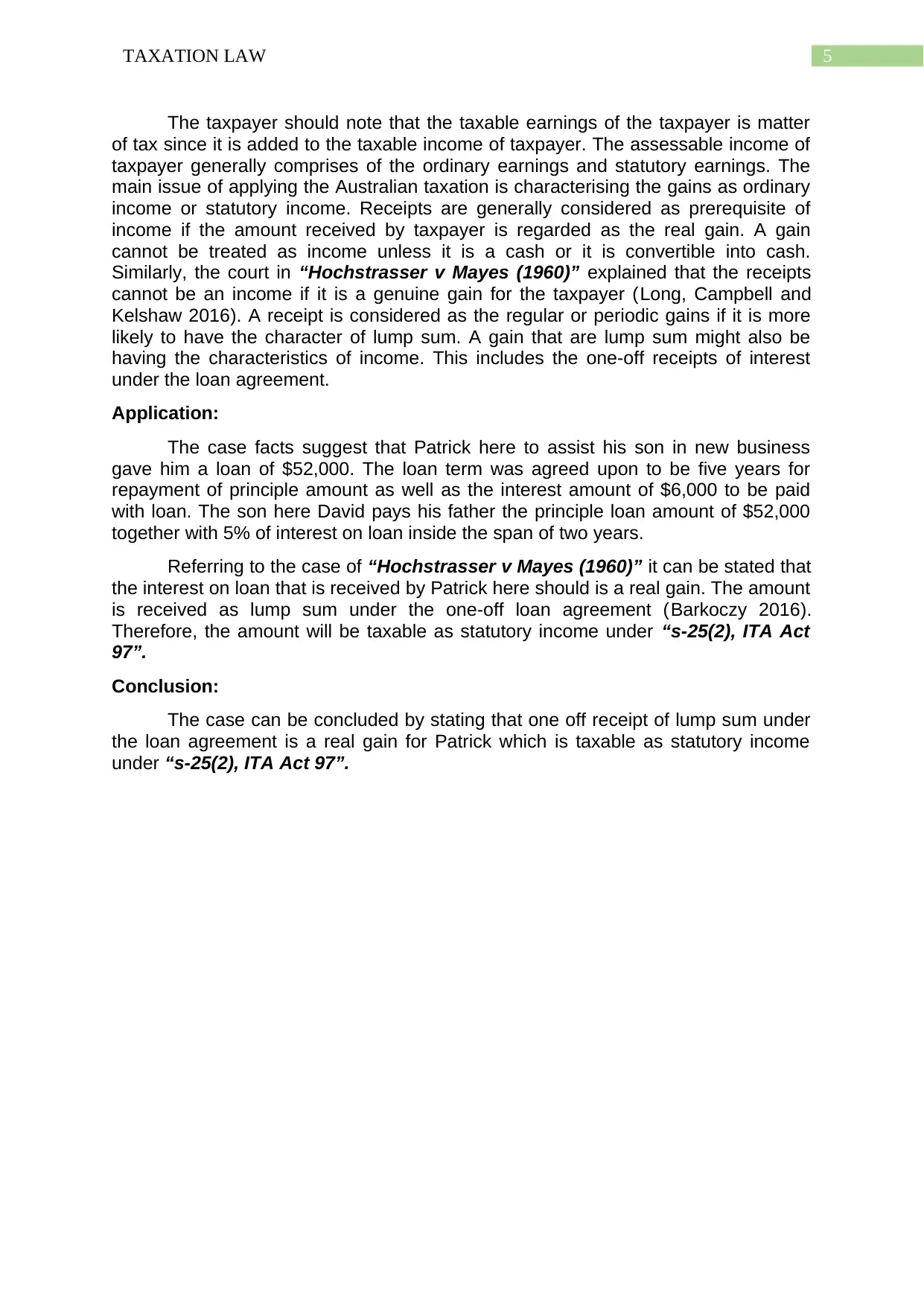
5TAXATION LAW
The taxpayer should note that the taxable earnings of the taxpayer is matter
of tax since it is added to the taxable income of taxpayer. The assessable income of
taxpayer generally comprises of the ordinary earnings and statutory earnings. The
main issue of applying the Australian taxation is characterising the gains as ordinary
income or statutory income. Receipts are generally considered as prerequisite of
income if the amount received by taxpayer is regarded as the real gain. A gain
cannot be treated as income unless it is a cash or it is convertible into cash.
Similarly, the court in “Hochstrasser v Mayes (1960)” explained that the receipts
cannot be an income if it is a genuine gain for the taxpayer (Long, Campbell and
Kelshaw 2016). A receipt is considered as the regular or periodic gains if it is more
likely to have the character of lump sum. A gain that are lump sum might also be
having the characteristics of income. This includes the one-off receipts of interest
under the loan agreement.
Application:
The case facts suggest that Patrick here to assist his son in new business
gave him a loan of $52,000. The loan term was agreed upon to be five years for
repayment of principle amount as well as the interest amount of $6,000 to be paid
with loan. The son here David pays his father the principle loan amount of $52,000
together with 5% of interest on loan inside the span of two years.
Referring to the case of “Hochstrasser v Mayes (1960)” it can be stated that
the interest on loan that is received by Patrick here should is a real gain. The amount
is received as lump sum under the one-off loan agreement (Barkoczy 2016).
Therefore, the amount will be taxable as statutory income under “s-25(2), ITA Act
97”.
Conclusion:
The case can be concluded by stating that one off receipt of lump sum under
the loan agreement is a real gain for Patrick which is taxable as statutory income
under “s-25(2), ITA Act 97”.
The taxpayer should note that the taxable earnings of the taxpayer is matter
of tax since it is added to the taxable income of taxpayer. The assessable income of
taxpayer generally comprises of the ordinary earnings and statutory earnings. The
main issue of applying the Australian taxation is characterising the gains as ordinary
income or statutory income. Receipts are generally considered as prerequisite of
income if the amount received by taxpayer is regarded as the real gain. A gain
cannot be treated as income unless it is a cash or it is convertible into cash.
Similarly, the court in “Hochstrasser v Mayes (1960)” explained that the receipts
cannot be an income if it is a genuine gain for the taxpayer (Long, Campbell and
Kelshaw 2016). A receipt is considered as the regular or periodic gains if it is more
likely to have the character of lump sum. A gain that are lump sum might also be
having the characteristics of income. This includes the one-off receipts of interest
under the loan agreement.
Application:
The case facts suggest that Patrick here to assist his son in new business
gave him a loan of $52,000. The loan term was agreed upon to be five years for
repayment of principle amount as well as the interest amount of $6,000 to be paid
with loan. The son here David pays his father the principle loan amount of $52,000
together with 5% of interest on loan inside the span of two years.
Referring to the case of “Hochstrasser v Mayes (1960)” it can be stated that
the interest on loan that is received by Patrick here should is a real gain. The amount
is received as lump sum under the one-off loan agreement (Barkoczy 2016).
Therefore, the amount will be taxable as statutory income under “s-25(2), ITA Act
97”.
Conclusion:
The case can be concluded by stating that one off receipt of lump sum under
the loan agreement is a real gain for Patrick which is taxable as statutory income
under “s-25(2), ITA Act 97”.
⊘ This is a preview!⊘
Do you want full access?
Subscribe today to unlock all pages.

Trusted by 1+ million students worldwide
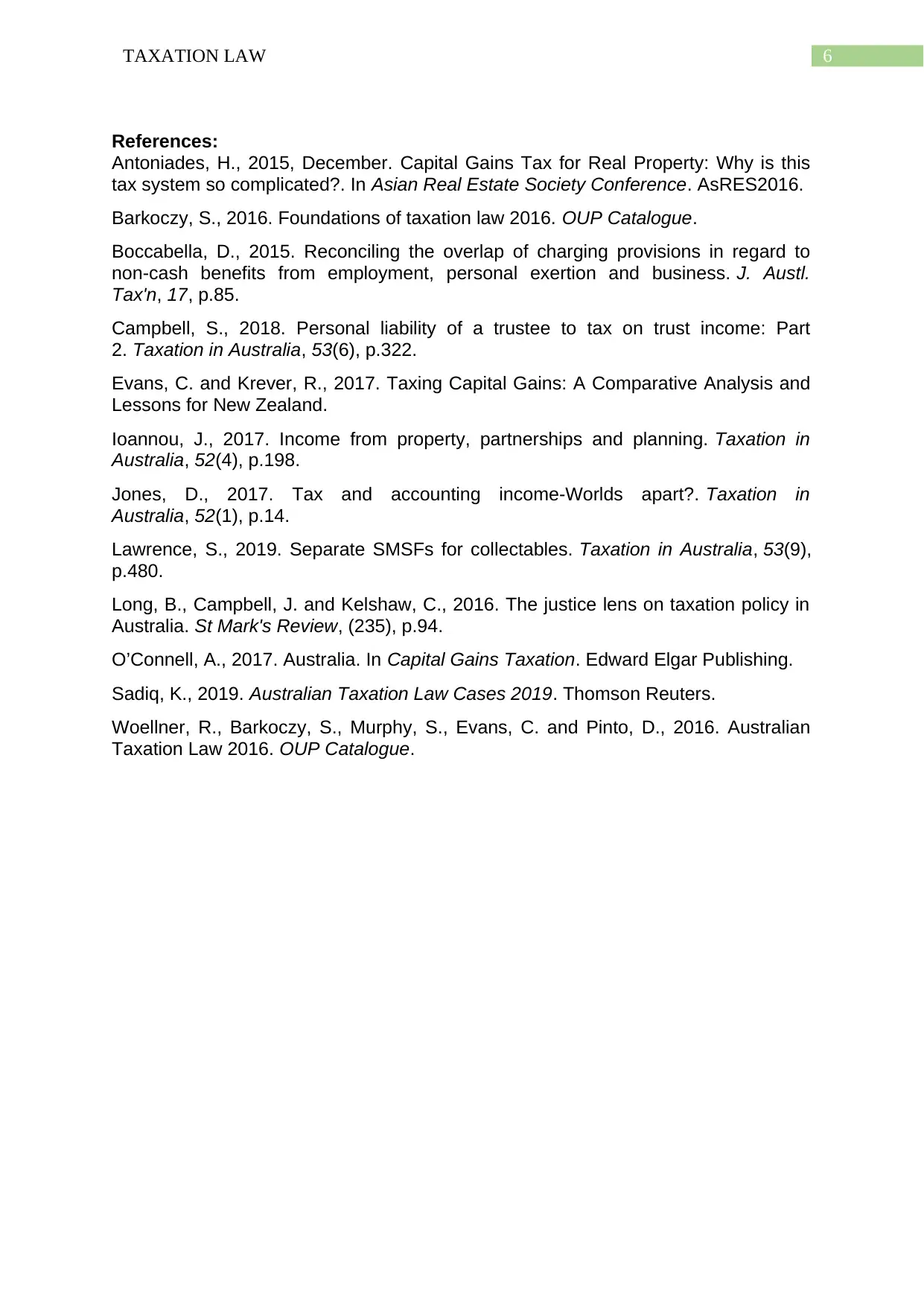
6TAXATION LAW
References:
Antoniades, H., 2015, December. Capital Gains Tax for Real Property: Why is this
tax system so complicated?. In Asian Real Estate Society Conference. AsRES2016.
Barkoczy, S., 2016. Foundations of taxation law 2016. OUP Catalogue.
Boccabella, D., 2015. Reconciling the overlap of charging provisions in regard to
non-cash benefits from employment, personal exertion and business. J. Austl.
Tax'n, 17, p.85.
Campbell, S., 2018. Personal liability of a trustee to tax on trust income: Part
2. Taxation in Australia, 53(6), p.322.
Evans, C. and Krever, R., 2017. Taxing Capital Gains: A Comparative Analysis and
Lessons for New Zealand.
Ioannou, J., 2017. Income from property, partnerships and planning. Taxation in
Australia, 52(4), p.198.
Jones, D., 2017. Tax and accounting income-Worlds apart?. Taxation in
Australia, 52(1), p.14.
Lawrence, S., 2019. Separate SMSFs for collectables. Taxation in Australia, 53(9),
p.480.
Long, B., Campbell, J. and Kelshaw, C., 2016. The justice lens on taxation policy in
Australia. St Mark's Review, (235), p.94.
O’Connell, A., 2017. Australia. In Capital Gains Taxation. Edward Elgar Publishing.
Sadiq, K., 2019. Australian Taxation Law Cases 2019. Thomson Reuters.
Woellner, R., Barkoczy, S., Murphy, S., Evans, C. and Pinto, D., 2016. Australian
Taxation Law 2016. OUP Catalogue.
References:
Antoniades, H., 2015, December. Capital Gains Tax for Real Property: Why is this
tax system so complicated?. In Asian Real Estate Society Conference. AsRES2016.
Barkoczy, S., 2016. Foundations of taxation law 2016. OUP Catalogue.
Boccabella, D., 2015. Reconciling the overlap of charging provisions in regard to
non-cash benefits from employment, personal exertion and business. J. Austl.
Tax'n, 17, p.85.
Campbell, S., 2018. Personal liability of a trustee to tax on trust income: Part
2. Taxation in Australia, 53(6), p.322.
Evans, C. and Krever, R., 2017. Taxing Capital Gains: A Comparative Analysis and
Lessons for New Zealand.
Ioannou, J., 2017. Income from property, partnerships and planning. Taxation in
Australia, 52(4), p.198.
Jones, D., 2017. Tax and accounting income-Worlds apart?. Taxation in
Australia, 52(1), p.14.
Lawrence, S., 2019. Separate SMSFs for collectables. Taxation in Australia, 53(9),
p.480.
Long, B., Campbell, J. and Kelshaw, C., 2016. The justice lens on taxation policy in
Australia. St Mark's Review, (235), p.94.
O’Connell, A., 2017. Australia. In Capital Gains Taxation. Edward Elgar Publishing.
Sadiq, K., 2019. Australian Taxation Law Cases 2019. Thomson Reuters.
Woellner, R., Barkoczy, S., Murphy, S., Evans, C. and Pinto, D., 2016. Australian
Taxation Law 2016. OUP Catalogue.
1 out of 7
Related Documents
Your All-in-One AI-Powered Toolkit for Academic Success.
+13062052269
info@desklib.com
Available 24*7 on WhatsApp / Email
![[object Object]](/_next/static/media/star-bottom.7253800d.svg)
Unlock your academic potential
Copyright © 2020–2026 A2Z Services. All Rights Reserved. Developed and managed by ZUCOL.





